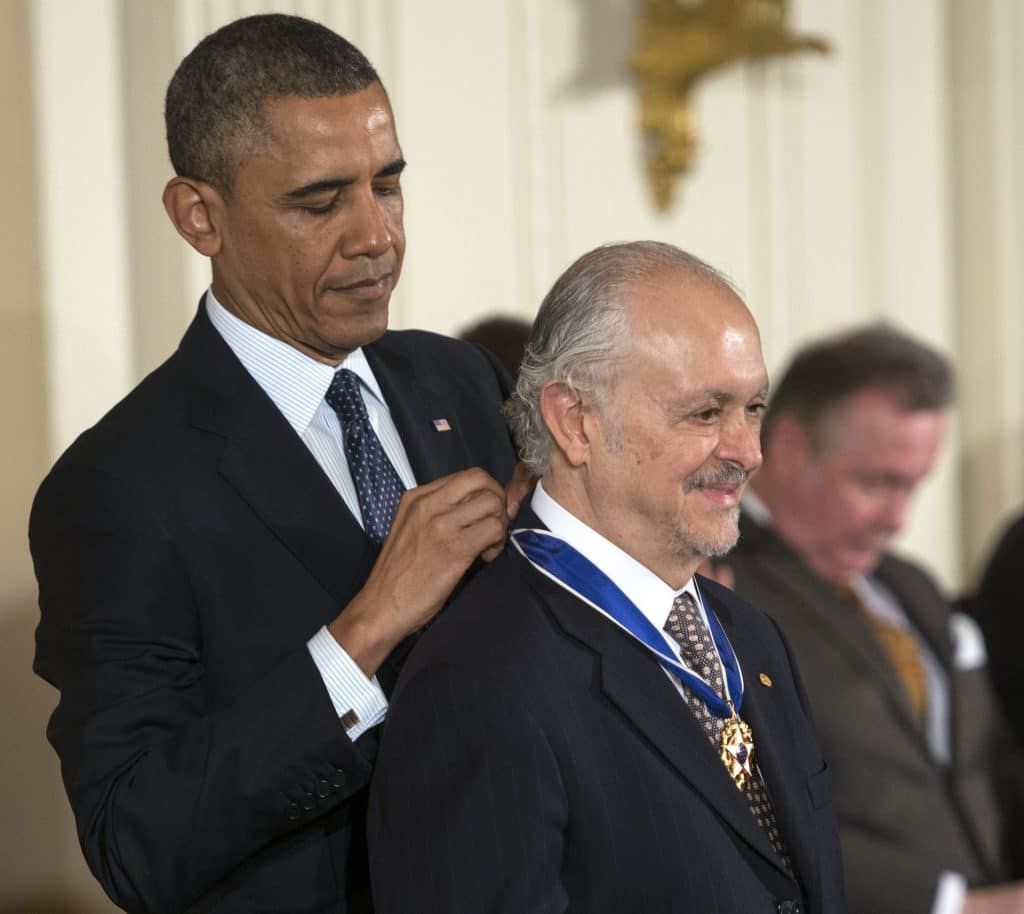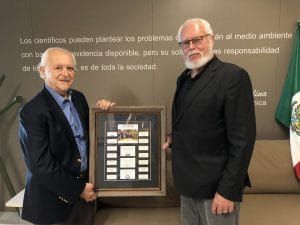Mario Molina: An appreciation from a colleague
By Durwood J. Zaelke | October 8, 2020
 Mario Molina receives the 2013 Presidential Medal of Freedom presented by President Barack Obama in the East Room of the White House. (Photo by Leigh Vogel/WireImage)
Mario Molina receives the 2013 Presidential Medal of Freedom presented by President Barack Obama in the East Room of the White House. (Photo by Leigh Vogel/WireImage)
The world lost a giant when Mario Molina passed away yesterday.
Mario was a brilliant scientist, a tireless advocate for the environment, and an inspiring collaborator. He also was a gracious gentleman and a generous friend.
Mario shared the 1995 Nobel Prize in Chemistry for discovering the threat that chlorofluorocarbons (CFCs) posed to the stratospheric ozone layer. He also should have received a Nobel Peace Prize for helping create the world’s best environmental treaty to address that threat, the Montreal Protocol on Substances that Deplete the Ozone Layer.
Mario was a tireless advocate for global controls on CFCs and related chemicals that were destroying the ozone layer, and worked throughout his lifetime to strengthen the Montreal Protocol. As a result, the protocol has phased out nearly 100 damaging chemicals by nearly 100 percent and put the ozone layer on the path to recovery by 2065. This has prevented millions of deaths from skin cancer and the suppression of our immune systems, prevented even more cataracts, and help all of us stay healthy. Mario did this.
But Mario didn’t stop with saving the ozone layer. He also took on climate change by helping strengthen the Montreal Protocol to explicitly focus on climate protection. The year after Mario and his colleague Sherwood Rowland published their 1974 CFC paper, another colleague of Mario’s at the University of California/San Diego, professor V. “Ram” Ramanathan, published a paper explaining that CFCs were powerful climate pollutants in addition to their role as ozone depleters.
Building on this climate insight, another group of scientists led by Guus Velders in The Netherlands was inspired to calculate the climate benefits achieved by phasing out CFCs. Analyzing a “world avoided” scenario, the Velders’ team reported that phasing out CFCs and related gases such as hydrochlorofluorocarbons, or HCFCs, had avoided warming that otherwise would have equaled or exceeded the warming caused by carbon dioxide. This helped convince the parties to the Montreal Protocol in 2007 to immediately accelerate the phaseout of HCFCs explicitly for climate protection, as well as ozone protection.
The next year Mario assembled another group of scientists and followed up with a paper in the Proceedings of the National Academy of Sciences (PNAS) describing the need for fast mitigation under the Montreal Protocol and other venues to keep the planet relatively safe.
One of our recommendations was to phase down hydrofluorocarbons (HFCs), which were strong climate pollutants but had only negligible impact on the ozone layer. After a long struggle, including a battle with the UN climate treaty over jurisdiction, the Montreal Protocol parties passed the Kigali Amendment to phase down HFCs. This has the potential to avoid up to 0.5 degrees Celsius of warming by the end of the century and represents the single biggest single bite out of the climate problem yet taken. Parallel improvements in the energy efficiency of cooling equipment during the switch out from HFCs can add significantly more climate protection.

Mario, Ram, and I had been working together for the past few months with an expanded team to update our earlier PNAS paper, to illuminate the need for speed—specifically to select strategies that can avoid the most warming in the shortest period of time—in order to slow the self-reinforcing feedbacks and avoid the catastrophic tipping points. The three of us outlined our approach in two essays in the Bulletin of the Atomic Scientists. (Climate report understates threat, October 9, 2018; Best path to net zero: Cut short-lived super-pollutants, April 2, 2020.)
Mario left us with unfinished work. But he laid down the tracks that showed us how we might still slow down global warming quickly enough to avoid the existential chaos we’ll face otherwise.
It’s up to his collaborators and friends, and all those he inspired, to carry on. And damn sure we will, but it won’t be as fun without our friend.
Together, we make the world safer.
The Bulletin elevates expert voices above the noise. But as an independent nonprofit organization, our operations depend on the support of readers like you. Help us continue to deliver quality journalism that holds leaders accountable. Your support of our work at any level is important. In return, we promise our coverage will be understandable, influential, vigilant, solution-oriented, and fair-minded. Together we can make a difference.
Keywords: CFCs, HCFCs, HFCs, Montreal Protocol, climate change, obituary
Topics: Climate Change, Special Topics















